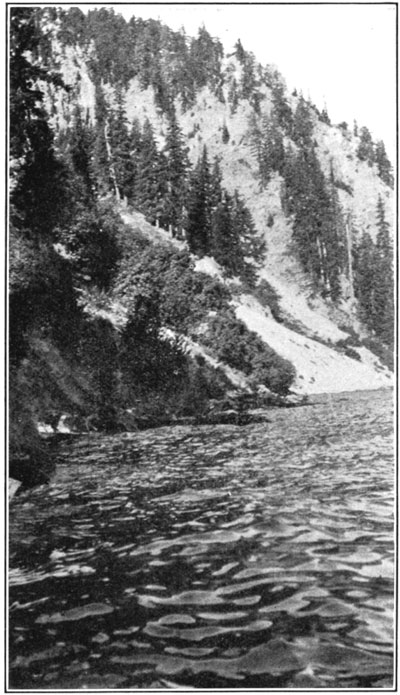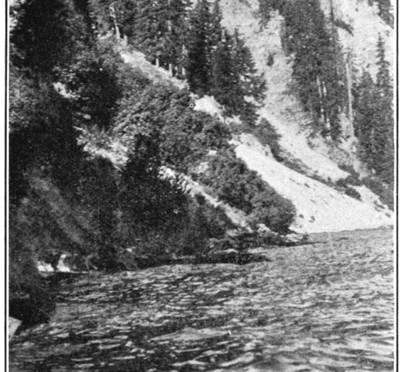Forests of Crater Lake National Park
Alpine Fir (Abies Lasiocarpa)
In the higher portions of the park is found the alpine fir (Abies lasiocarpa), a small graceful tree whose limby trunks rarely exceed 80 or 90 feet in height (figs. 13 and 14). The crowns of these trees are remarkably conical and slender, and are prolonged into tall, narrow spires, both when young and in old age. This spire-shaped crown is very distinctive, and by it this tree can be distinguished at once from all other species with which it is found. When growing in the open the crowns extend nearly to the ground, but in close stands the lower limbs finally die and become bent downward tightly against the small trunk. The bark of this fir is smooth, hard, and chalky white in color, and its thinness makes the trees very easily killed, even by light surface fires. The foliage of alpine fir is dark, blue-green, and the small cones, which are produced abundantly every two or three years, are borne mostly on the upper portion of the slender crown.

Fig. 13—Within the crater of former Mount Mazama. This view from the surface of the lake shows the scattered groups of alpine fir and other conifers on the steep inner slopes.
Photograph by H. H. Barbur.
It is mainly this fir that ornaments the slopes and ledges in Anna Creek Canyon, and which finds a precarious foothold on the steep and rocky inner walls of the crater of Mount Mazama. It is abundant throughout much of the park, from about 6,000 feet up to the local timber line that exists on several of the higher peaks, and on the outer slopes of Mount Mazama it forms, with mountain hemlock and western white pine, a considerable portion of the forest cover.
Fig. 14—View of Anna Creek Canyon from the Fort Klamath-Crater Lake Road. The trees in the foreground are mainly alpine fir.
Photograph by H. H. Barbur.
(sorry, photo is missing)
Alpine fir is widely distributed throughout much of the highest portions of the Cascade and Rocky Mountains from Alaska to Arizona and New Mexico. It is essentially a tree of high altitudes, seeming to prefer those situations where the winds blow the strongest and the winter snows pile the deepest around its slender spires.
On account of its small size alpine fir is used little, except occasionally for miners’ cabins in the highest mountains. The greatest value of this species is its power to form a partial forest cover in barren situations near timber line.
Other pages in this section
*** previous title *** --- *** next title ***


